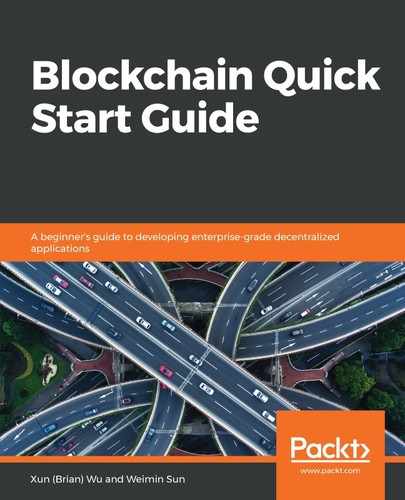If someone buys a bottle of water for $1, that person cannot spend the same $1 to buy a can of coke. If a person is free to double-spend a dollar, money would be worthless since everyone would have unlimited amounts and the scarcity, which gives the currency its value, would disappear. This is called the double-spending problem. With BTC, double spending is the act of using the same Bitcoin more than once. If this problem is not resolved, BTC loses its scarcity and cannot be used to facilitate a trade between two untrusting parties. The Bitcoin Core network protects against double spends via a consensus mechanism. To explain how the Bitcoin consensus mechanism works, we first describe the concepts of PoW (Proof-of-Work) and mining.
As explained earlier, a miner needs to solve a difficult mathematical puzzle ahead of other miners in order to receive the role of being a builder of the current new block and receive a reward for doing the work. The work of resolving the math problem is called PoW.
Why is PoW needed? Think of this: in a network consisting of mutually untrusting parties, more honest parties are needed than dishonest attackers in order to make the network function. Imagine if upon collecting sufficient transactions for a new block, a miner is allowed to build the new block immediately. This simply becomes a race for whoever can put enough transactions together quickly. This leaves a door wide open for malicious attackers to hack the network by including invalid or fake transactions and always win the race. This would allow hackers to double-spend BTCs freely.
Therefore, to prevent attackers from introducing bad transactions, a sufficient window of time is needed for participating nodes to verify every transaction's validity by making sure a BTC has not been spent yet. Since every node maintains a copy of the ledger, an honest miner can trace the history and ensure the following to confirm the validity of a transaction:
- The requestor of a transaction does own the BTCs.
- The same BTCs have not been spent by any other transactions in the ledger.
- The same BTCs have not been spent by other transactions within the candidate block.
This window of time is currently set to be around 10 minutes. To enforce the 10-minute waiting time, Bitcoin asks a miner to solve a sufficiently difficult mathematical puzzle. The puzzle requires only a simple computation. Miners have to repeat the same computation many times in order to burn enough CPU time to reach the network's goal of building a new block every 10 minutes on average. The process of repeated guessing is called mining and the device (specially made) is called a mining rig.
Since, in order to win the mining race, a miner needs to invest heavily in hardware, these miners are dedicated to the work of mining and aim to receive sufficient BTCs to cover the cost of running the mining operation and make a profit. As of the first half of 2018, the reward given to a winning miner is 12.5 BTCs. One can find the price of BTC by visiting the CoinMarketCap website (https://coinmarketcap.com/). As of September 21, 2018, one BTC is traded at around $6,710. Therefore, 12.5 BTC is worth about $83,875 USD.
Per Bitcoin protocol, mining is the only way for a new BTC to be issued (minted). Having a miner be rewarded handsomely serves three purposes:
- Compensates a miner's investment on hardware.
- Covers mining operational costs such as utility bills, which can be significant due to the large mining rigs being deployed at a mining site, human salaries, and site rentals.
- Gives miners incentives to safeguard the network from being attacked by malicious hackers. Miners are motivated to maintain the Bitcoin network in order not to lose value in their BTCs and their mining infrastructure. If Bitcoin is breached by hackers, Bitcoin's reputation will suffer badly and BTC prices would freefall. This is exactly what the Bitcoin inventor hoped for: having more good miners than bad miners to address the double-spending issue.
The total number of BTC that can be issued is fixed to be 21 million. As of today (September 19, 2018), around 17 million BTCs have been issued. The Bitcoin protocol defines a rule for dynamically adjusting the payout rate and the remaining 4 million coins aren't expected to be mined completely for another 122 years. The following point explains how the block creation payout rate is dynamically adjusted:
- The rate changes at every 210,000 blocks. It is a function of block height on the chain with genesis=0, and is calculated using 64-bit integer operations such as: (50 * 100000000) >> (height / 210000). The rate initially started with 50 BTCs, and fell to 25 BTCs at block 210,000. It fell to 12.5 BTCs at block 420,000, and will eventually go down to 0 when the network reaches 6,930,000 blocks.
